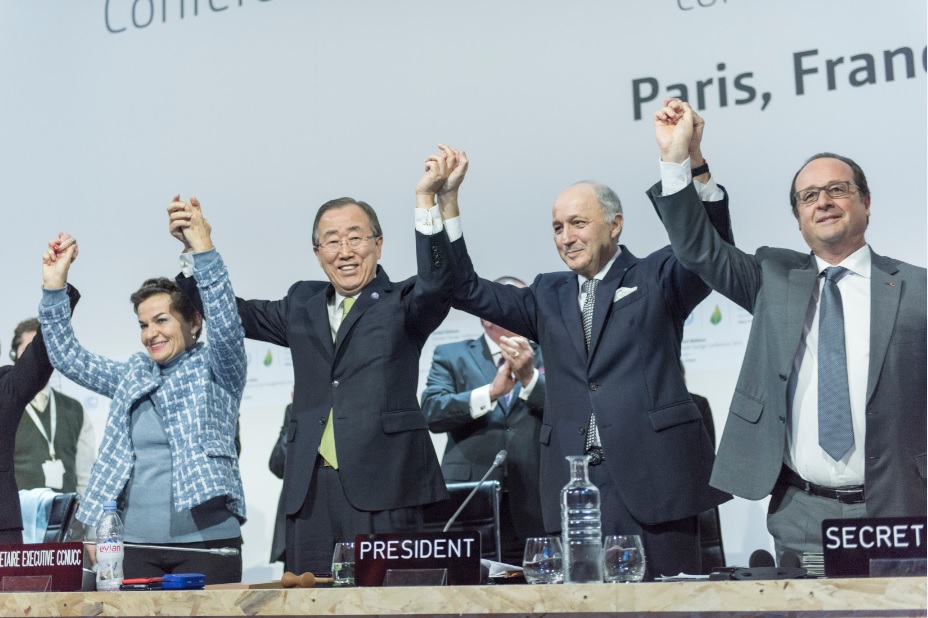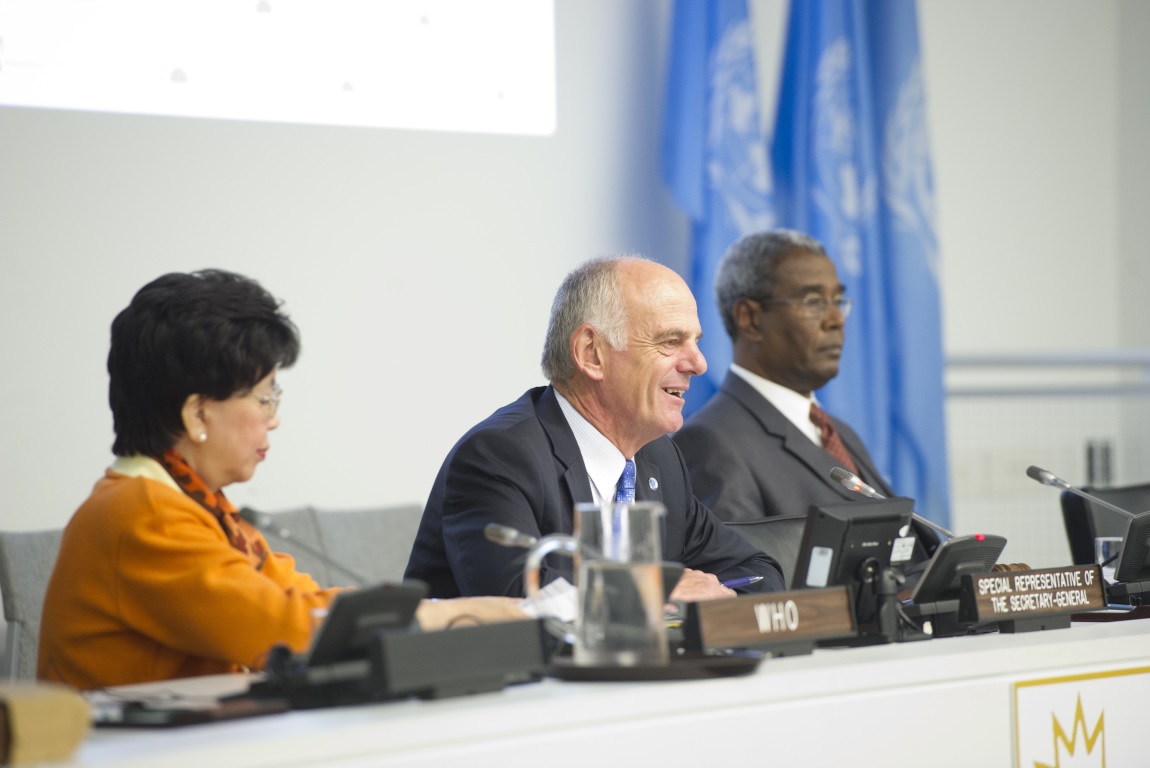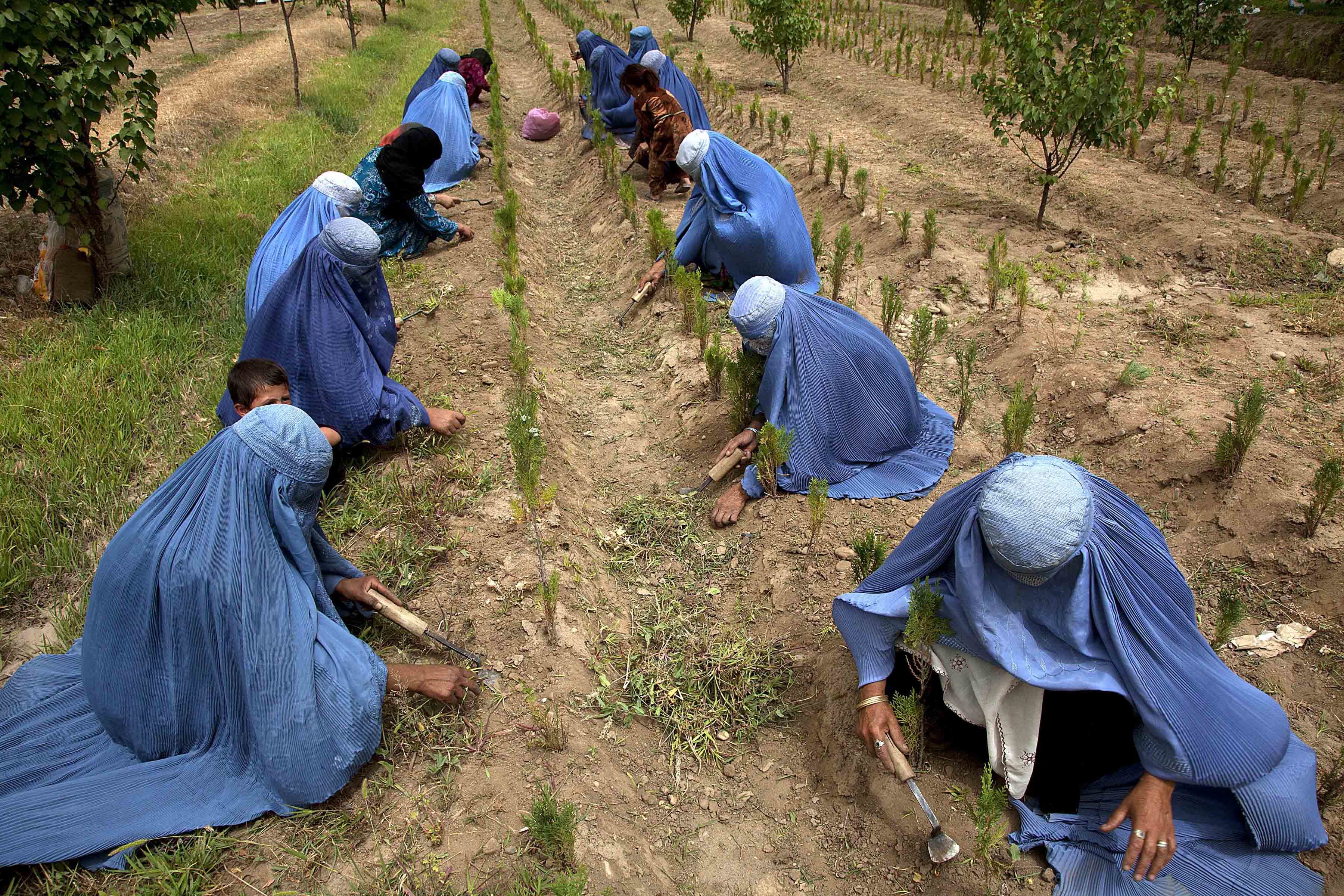2015 was a fruitful year for the United Nations. It began with the adoption by 193 UN Member States of the Addis Ababa Action Agenda last summer that established a new framework for funding sustainable development; it continued in September with the unanimous adoption by the UN General Assembly of Agenda 2030, including its 17 Sustainable Development Goals (SDGs) and 169 targets, committing the world to achieving sustainable development in the next 15 years. Two months later, COP21 hosted by France in Paris led to a successful world agreement on climate, with pledges to curb greenhouse emissions coming from most countries, including major polluters like the US and China. François Hollande, the French President, proudly told the press, “We’ve transformed the United States into the global leader in fighting climate change.”

In the photo: Closing Ceremony of COP21 – Secretary-General Ban Ki-moon (second left); Christiana Figueres (left), Executive Secretary of the UN Framework Convention on Climate Change (UNFCCC); Laurent Fabius (second right), Minister for Foreign Affairs of France and President of the UN Climate Change Conference in Paris (COP21) and François Hollande (right) – 12 December 2015 Paris, France – Photo Credit: UN Photo/Mark Garten
A victory for the UN and the world? Not quite.
Rising Challenges
To begin with, as a result of the current collapse in oil prices, alternative “green” energies suddenly look expensive and at least one major developing country (India) could be sorely tempted to continue on its fossil-fueled development path – if nothing else, to provide electricity to its 300 million people who still have no access to it.
With a recent Supreme Court decision putting a stop to President Obama’s coal emissions regulations, the chances that the United States are going to be a “global player” in climate action are looking increasingly slim.
Finding the funds to finance development and the climate change deal is another huge challenge – though there is nothing new here, funding has historically always been insufficient for both humanitarian and development needs. Governments, both in the West and the rest, have always had other priorities (primarily military).
There is however some hope on this front: the Addis Ababa Action Agenda is viewed favorably by the OECD that comprises most of the world’s largest donor countries, calling it “a milestone in forging an enhanced global partnership.” A further step in that direction was taken on 17 January 2016 in Dubai, when a report titled “Too Important to Fail” by a High Level Panel of experts appointed by the UN Secretary General proposed a so-called “Grand Bargain” – whereby aid delivery would be improved by calling on the five major donor countries and six UN agencies that deliver most of the aid to work closer together, reform the system and improve efficiency, thus setting an example for the rest of the international community. The upcoming World Humanitarian Summit, to be held in Turkey in May, will be a perfect opportunity to move the dialogue forward with donors.
The third challenge is more subtle but could ultimately make or break Agenda 2030. Can the UN equip itself with a governance system that will help the world achieve the sustainable development goals of Agenda 2030?
A Matter of Stewardship
Ban Ki-moon, the UN Secretary General who is retiring at the end of this year, has every intention of leaving a legacy behind: he wants to be remembered as the man who successfully launched Agenda 2030. Although the UN is a troubled institution, with a Security Council in the hands of the Big Five (US, China, Russia France and the UK, the permanent five members with veto power), it is nevertheless the only world organization capable of steering the global political discourse forward – as demonstrated with the way it managed to obtain a deal on climate change after over two decades of failed negotiations, no small feat.

In the photo: Special Representative Addresses High-Level Meeting on Food and Nutrition – David Nabarro (centre), Special Representative of the Secretary-General on Food Security and Nutrition, addresses the high-level meeting on food and nutrition convened by Secretary-General Ban Ki-moon. Next to Mr. Nabarro is Margaret Chan (left), Director-General of the World Health Organization (WHO). 20 September 2011 – United Nations, New York – Photo Credits: UN Photo/Mark Garten
In January, the Secretary General called on Dr. David Nabarro to act as his “Special Adviser” to help jump start the implementation of Agenda 2030. Dr. Nabarro appears ideally suited for the task, having just brought to a happy close the UN coordination work in the Ebola crisis. He has also been coordinator for the successful Scaling Up Nutrition Movement (SUN) since 2012. In short, he is generally viewed as someone who knows well how the UN is run – particularly the new UN, no longer an opaque intergovernmental organization running behind closed doors but one open to the whole range of civil society, from NGOs and people’s movements to business; and that happens to be exactly how SUN is organized: as a multi-stakeholder platform, with a voice given to everyone in the public and private sector.
Related articles: “#SDGStories— LAUNCH OF OUR SUSTAINABLE DEVELOPMENT GOALS SERIES”
“SDG 5: ACHIEVING GENDER EQUALITY”
Dr. Nabarro functions with a small team in the Secretary General’s office and earlier this month, he took his first trip out of New York to talk to the World Food Programme’s Governing Council on February 8. This was the first time that he revealed to one of the “sister” UN agencies the thrust of the Secretary General’s new plan for implementation of the SDGs.
What exactly did Dr. Nabarro tell the WFP Council? It was revealing. You can find his address online here. What he said can be summed up in one key sentence:
No part of the United Nations should seek to ‘own’ any one of the goals. Instead we see ourselves as working across all the goals.
This, he said, was a quote from Ban Ki-moon. The implications are numerous and far-reaching.
One, this is how the UN Secretary General wishes to see the UN gearing up to implement the SDGs. As he told Dr. Nabarro, he doesn’t want to “waste” the first four or five years, the way it happened when the Millennium Development Goals were launched, back in 2000. This is a powerful argument to force everyone to pay attention – particularly in a deeply hierarchized institution like the UN where the head counts and staff is expected to follow orders.
Two, this puts a stop to UN agency declaring themselves responsible for this or that SDG. Dr. Nabarro was eloquent on this point, reminding the World Food Programme, the Food and Agriculture Organization (FAO) and the International Fund for Agricultural Development (IFAD), the three Rome-based UN agencies, that SDG#2, zero hunger and sustainable agriculture, could perhaps be seen as their goal since all three “work intensively on food and agriculture.”
But it’s not so simple.
In the photo: Projections on Sustainable Development Goals and 70th Anniversary of the United Nations. Ahead of the United Nations Sustainable Development Summit from 25-27 September, and to mark the 70th anniversary of the United Nations, a 10-minute film introducing the Sustainable Development Goals is projected onto the UN Headquarters, north façade of the Secretariat building, and west façade of the General Assembly building. The projection brings to life each of the 17 Goals, to raise awareness about the 2030 Agenda for Sustainable Development. 22 September 2015 – United Nations, New York – Photo Credit: UN Photo/Cia Pak
One must consider, he told his audience, that Agenda 2030 is “indivisible.” Therefore, SDG# 2, zero hunger is actually directly “linked to poverty reduction, social protection, gender equity, both sustainable production and consumption, and partnerships.” And those, he pointed out, are contained in SDG#1 (no poverty), SDG#5(gender equality), SDG#8 (decent work and economic growth), SDG#17 (partnerships).
To add to Dr. Nabarro’s argument, let’s not forget that “sustainable production and consumption” also require support from SDG#12(responsible consumption, production), SDG#13 (climate action), SDG#14 (life below water), SDG#15 (life on land), SDG#3 (Good health and well-being), SDG#4 (quality education). And of course, for all this to happen, partnerships with civil society and other UN agencies are not enough, there is also a need to strive towards SDG#10 (reduced inequalities) and SDG#16 (peace, justice and strong institutions). Without a supportive institutional, social and political framework, sustainable development cannot be achieved.
In fact, the linkages between SDGs turned up, just a week later after Dr. Nabarro’s intervention at the WFP, at the IFAD Governing Council meeting (February 17-18). In his opening address to the Council, Kanayo F. Nwanze, the President of IFAD, mentioned that IFAD was not only working towards SDG#1 (no poverty) and SDG#2 (zero hunger) but also towards SDG#5 (gender equality) and SDG#8 (decent work and economic growth). He made the point that IFAD saw its own strategy of “inclusive investment,” bringing together public and private funding, as the way forward, in line with Agenda 2030. Is IFAD mistaken in its pretensions? No, the projects it finances do work towards overall rural development, helping smallholder farmers to achieve all those goals. And the help is far from insignificant. IFAD projects, in the 2010-2015 period have reached 139 million people and ensured that 40 million of them have already achieved “significantly higher agricultural revenue”.
Arguably, the only SDGs that do not impact directly on the work of the UN hub of food and agriculture agencies are SDG#11 (sustainable cities and communities), SDG#6 (clean water and sanitation), SDG#7 (affordable and clean energy), SDG#9 (industry, innovation, infrastructure) – although a good argument could be made that rural communities to be sustainable certainly also need electricity, clean water and sanitation and a modicum of local job-making industrial activities.
How then do you implement such an “indivisible” agenda without causing confusion and having the UN agencies walking over each other’s toes – a phenomenon known in UN circles as “mission creep?” However, to give up on the task and allow every UN agency to its own devices, working within its own mandate as it has done in the past – in short, allowing business to proceed as usual – is a recipe for missing out on the SDGs; to achieve them will require full coordination and a special push.
The solution: multi-stakeholder and multi-domain platforms
While recognizing that, at present, “tidy architectures do not exist,” Dr. Nabarro argued forcefully that “it is not impossible” to establish platforms in which “multiple stakeholders work for a shared objectives”; he referred to his recent experience with SUN as a model to follow. But he could have equally well mentioned the much older and larger Committee on World Food Security (CFS), historically the first of its kind and largest global multi-stakeholder “platform” in the UN system.
it is not impossible” to establish platforms in which “multiple stakeholders work for a shared objectives
– Dr. Nabarro
To understand the complexity of the solution proposed by Dr. Nabarro, it is useful to briefly consider CFS history and how it functions. To get where it is today was not easy: the CFS has been functioning as an intergovernmental forum since its establishment in 1974 by FAO for review and follow-up of food security policies. It was only in 2009, thirty years after it was founded, that it underwent a final reform to open it up to civil society and ensure that the global debate on food security and nutrition remained inclusive of all stakeholders.
Major working elements of the CFS architecture include (1) the CFS Civil Society Mechanism (CSM) that speaks for NGOs and People’s Movements, (2) its sister Mechanism to give voice to business and (3) a scientific panel (known as HLPE, High Level Panel of Experts on Food Security and Nutrition), entirely funded through voluntary contributions and called upon to provide scientific knowledge-based analysis and advice to inform the CFS decision-making process. While core funding comes from the UN hub (FAO, WFP, IFAD), voluntary contributors for the biennium 2016 – 2017 include the European Union, France, Switzerland and the Bill and Melinda Gates Foundation.

In the photo: The United Nations, through its International Fund for Agricultural Development (IFAD), will provide a grant of US$58 million to Afghanistan for an initiative aimed at improving food security by enhancing the skills, services and income opportunities of rural women and men. The project seeks to improve agriculture and livestock productivity by building the capacity of community organizations and local government agencies to buoy locally-owned and led development. Photo credit: UN Photo/Fardin Waezi
The CFS conclusively demonstrates that three major UN agencies (FAO, WFP and IFAD) can work together with governments and civil society. It also shows the importance of putting into place some key institutional mechanisms to represent majority interest groups ranging from business to people’s movements, as well as establishing reliance on a committee of independent scientists to keep debates in the forum within the bounds of objective reality. The model works – though it may not satisfy everyone and some elements of civil society are still unhappy with the CFS, demanding a greater voice in decision-making.
Related articles: “SDG 14: GROWING BLUE OCEANS”
“SDG 13: TAKING CLIMATE ACTION“
The CFS took time to get where it is today, and this suggests that – although we do have a working model – it won’t be easy or quick to establish fully-functioning “multi-stakeholder platforms” for Agenda 2030 implementation.
The question immediately comes to mind: what platforms would cover what domains and under whose guidance? The answers again are not simple and Dr. Nabarro said his team was working on it, as well as many governments and agencies within the framework of ECOSOC; because the platforms would need to be, as explained by Dr. Nabarro, not only multi-domain but also multi-functional. He identified five functions to be covered:
(1) financing, what instruments are “right” for this Agenda;
(2) data needed to monitor progress;
(3) capabilities building/new skills needed;
(4) communications and campaigning;
(5) engaging young people.
Why the young? Because, he said, the young are “particularly comfortable with this new Agenda because for them it is closer to reality and to their concerns about their future.”
New Forms of Matrix Management
All this would clearly require new forms of “matrix management.” A bit of “governance” innovation is needed here, we are moving into uncharted territory. Dr Nabarro appeared to be clearly aware of the difficulties. He spent much time explaining that the new Agenda would require everyone to learn to work differently – not just the United Nations secretariat. The Agenda applied to all countries, unlike the MDGs that focused particularly on developing countries. “Crosswalks” would have to be built; “silos” would need to be broken down. This implies that new ways of working must be found in governments, academe, advocacy groups and, of course, the UN system. He acknowledged this is “uncomfortable”; it cannot be “twisted to suit one’s business.” Admittedly this “creates challenges for the governing bodies of UN organizations that would like their organizations to stay tight and focused on their core business.”
A tall order.
At best, establishing such a new global institutional architecture and methods of work will take time; at worst, it will cause confusion, delays, duplication and “mission creep” among UN agencies as each vies for a piece of the action.
Yet it’s unlikely that one can move forward on Agenda 2030 in other ways without leaving someone or something behind. Dr. Nabarro reminded his audience that in moving towards Agenda 2030, people should always be placed at the center: progress towards the SDGs is to be measured in relation to the people. For that, he said, is what is at the heart of Agenda 2030: Human rights, the idea of “leaving no one behind”, a concept that cuts across the whole Agenda. SDGs are no longer focused on averages but on the 10% that was missed out with the previous Millennium Development Goals (2000-2015). In that sense, the SDGs are a moral improvement over the MDGs.
It will be interesting to see how quickly and where multi-stakeholder platforms get established. There is no doubt that the approach, however unwieldy and slow, is one of the true and tested ways the United Nations has met – and survived – challenges to its agenda in the past. The hope is that it can continue to do so and ensure that, as we approach 2030, the SDGs are (mostly) achieved.
_ _










